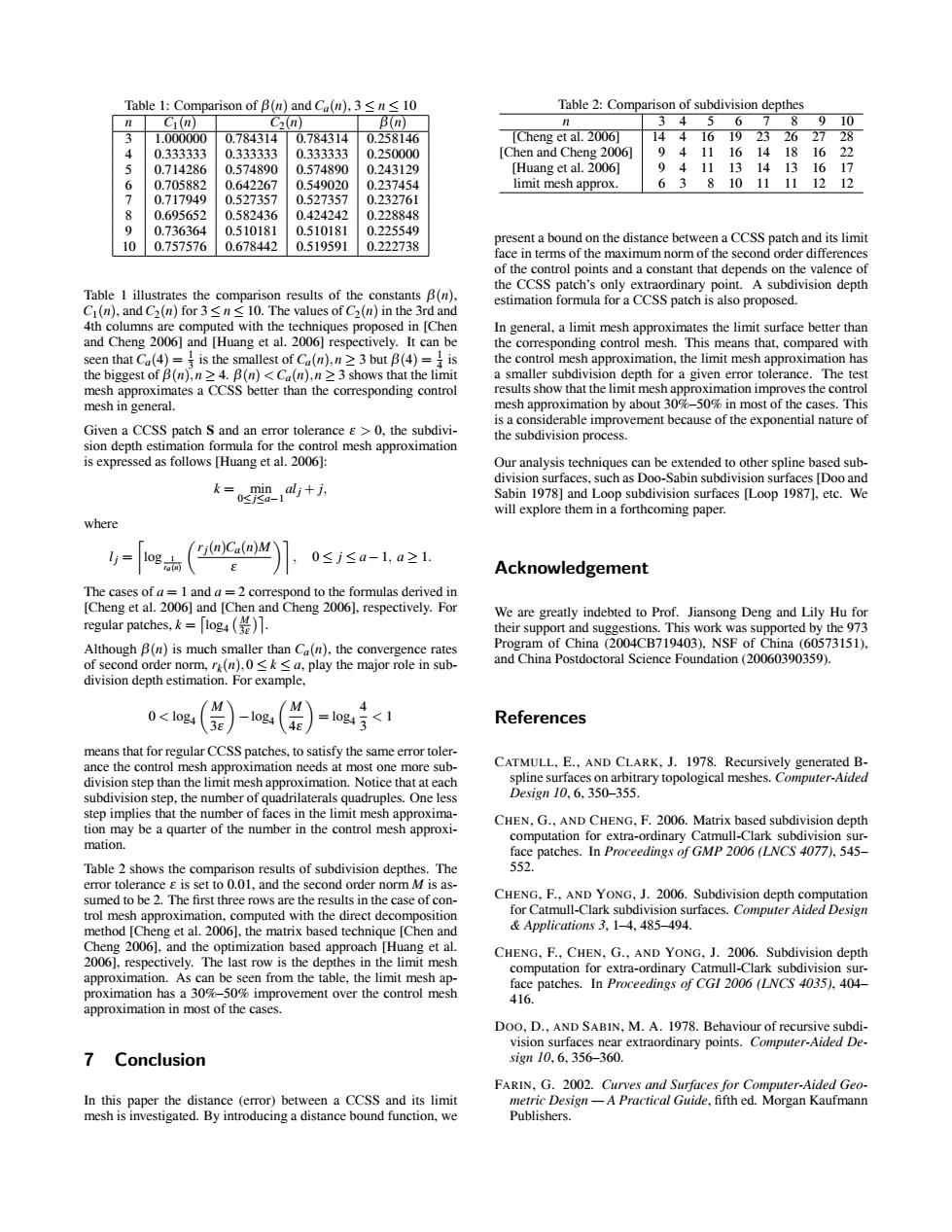正在加载图片...

于 空围 =a肥叫+五 whcrc -e克(o恤l,a<i区a-lw≥1 Acknowledgement 0<()-oe(0)=< References 之 AND C CQCA8 7 Conclusion aeeeamtganan h地C Table 1: Comparison of β(n) and Ca(n), 3 ≤ n ≤ 10 n C1(n) C2(n) β(n) 3 1.000000 0.784314 0.784314 0.258146 4 0.333333 0.333333 0.333333 0.250000 5 0.714286 0.574890 0.574890 0.243129 6 0.705882 0.642267 0.549020 0.237454 7 0.717949 0.527357 0.527357 0.232761 8 0.695652 0.582436 0.424242 0.228848 9 0.736364 0.510181 0.510181 0.225549 10 0.757576 0.678442 0.519591 0.222738 Table 1 illustrates the comparison results of the constants β(n), C1(n), and C2(n) for 3 ≤ n ≤ 10. The values of C2(n) in the 3rd and 4th columns are computed with the techniques proposed in [Chen and Cheng 2006] and [Huang et al. 2006] respectively. It can be seen that Ca(4) = 1 3 is the smallest of Ca(n),n ≥ 3 but β(4) = 1 4 is the biggest of β(n),n ≥ 4. β(n) <Ca(n),n ≥ 3 shows that the limit mesh approximates a CCSS better than the corresponding control mesh in general. Given a CCSS patch S and an error tolerance ε > 0, the subdivision depth estimation formula for the control mesh approximation is expressed as follows [Huang et al. 2006]: k = min 0≤j≤a−1 alj + j, where lj = log 1 ra(n) rj(n)Ca(n)M ε
, 0 ≤ j ≤ a−1, a ≥ 1. The cases of a = 1 and a = 2 correspond to the formulas derived in [Cheng et al. 2006] and [Chen and Cheng 2006], respectively. For regular patches, k = log4 M 3ε . Although β(n) is much smaller than Ca(n), the convergence rates of second order norm, rk(n),0 ≤ k ≤ a, play the major role in subdivision depth estimation. For example, 0 < log4 M 3ε
−log4 M 4ε
= log4 4 3 < 1 means that for regular CCSS patches, to satisfy the same error tolerance the control mesh approximation needs at most one more subdivision step than the limit mesh approximation. Notice that at each subdivision step, the number of quadrilaterals quadruples. One less step implies that the number of faces in the limit mesh approximation may be a quarter of the number in the control mesh approximation. Table 2 shows the comparison results of subdivision depthes. The error tolerance ε is set to 0.01, and the second order norm M is assumed to be 2. The first three rows are the results in the case of control mesh approximation, computed with the direct decomposition method [Cheng et al. 2006], the matrix based technique [Chen and Cheng 2006], and the optimization based approach [Huang et al. 2006], respectively. The last row is the depthes in the limit mesh approximation. As can be seen from the table, the limit mesh approximation has a 30%–50% improvement over the control mesh approximation in most of the cases. 7 Conclusion In this paper the distance (error) between a CCSS and its limit mesh is investigated. By introducing a distance bound function, we Table 2: Comparison of subdivision depthes n 3 4 5 6 7 8 9 10 [Cheng et al. 2006] 14 4 16 19 23 26 27 28 [Chen and Cheng 2006] 9 4 11 16 14 18 16 22 [Huang et al. 2006] 9 4 11 13 14 13 16 17 limit mesh approx. 6 3 8 10 11 11 12 12 present a bound on the distance between a CCSS patch and its limit face in terms of the maximum norm of the second order differences of the control points and a constant that depends on the valence of the CCSS patch’s only extraordinary point. A subdivision depth estimation formula for a CCSS patch is also proposed. In general, a limit mesh approximates the limit surface better than the corresponding control mesh. This means that, compared with the control mesh approximation, the limit mesh approximation has a smaller subdivision depth for a given error tolerance. The test results show that the limit mesh approximation improves the control mesh approximation by about 30%–50% in most of the cases. This is a considerable improvement because of the exponential nature of the subdivision process. Our analysis techniques can be extended to other spline based subdivision surfaces, such as Doo-Sabin subdivision surfaces [Doo and Sabin 1978] and Loop subdivision surfaces [Loop 1987], etc. We will explore them in a forthcoming paper. Acknowledgement We are greatly indebted to Prof. Jiansong Deng and Lily Hu for their support and suggestions. This work was supported by the 973 Program of China (2004CB719403), NSF of China (60573151), and China Postdoctoral Science Foundation (20060390359). References CATMULL, E., AND CLARK, J. 1978. Recursively generated Bspline surfaces on arbitrary topological meshes. Computer-Aided Design 10, 6, 350–355. CHEN, G., AND CHENG, F. 2006. Matrix based subdivision depth computation for extra-ordinary Catmull-Clark subdivision surface patches. In Proceedings of GMP 2006 (LNCS 4077), 545– 552. CHENG, F., AND YONG, J. 2006. Subdivision depth computation for Catmull-Clark subdivision surfaces. Computer Aided Design & Applications 3, 1–4, 485–494. CHENG, F., CHEN, G., AND YONG, J. 2006. Subdivision depth computation for extra-ordinary Catmull-Clark subdivision surface patches. In Proceedings of CGI 2006 (LNCS 4035), 404– 416. DOO, D., AND SABIN, M. A. 1978. Behaviour of recursive subdivision surfaces near extraordinary points. Computer-Aided Design 10, 6, 356–360. FARIN, G. 2002. Curves and Surfaces for Computer-Aided Geometric Design — A Practical Guide, fifth ed. Morgan Kaufmann Publishers